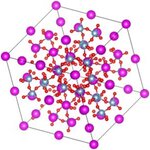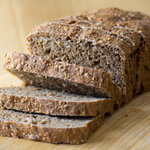Chemistry

Image: Jeff Kubina via flickr, CC BY
BY Jyoti Madhusoodanan, Inside Science
(Inside Science) -- Showers fall to Earth’s surface as rain, snow, sleet or hail. But high in the clouds, water molecules often begin to come together as tiny ice crystals that form around miniscule particles of dust. The microscopic crystals are big players in creating rain and lightning, and also heat and cool the planet by bouncing sunlight off clouds.
The airborne dust particles that seed ice crystals – a mix of minerals, soil, microbes, and pollutants – are swirled into the atmosphere from both…

A new study finds that fructose is bad. Biologists who fed mice sugar in doses proportional to what many people eat found that the ratio of fructose and glucose in high-fructose corn syrup was more toxic than than random variations found in sucrose (table sugar). They conclude that the precisely-determined fructose reduced both the reproduction and lifespan of female rodents.
High-fructose corn syrup found in many processed foods and the table sugar found in baked goods contain roughly equal amounts of fructose and glucose whereas in table sugar you are never sure how much of each…

Current carbon capture schemes are not really ready for prime time, plagued by toxicity, corrosiveness and inefficiency, but a team of chemists have invented low-toxicity, highly effective carbon-trapping "sponges" that could lead to increased use of the technology.
Used in natural gas and coal-burning plants, the most common carbon capture method today is called amine scrubbing, in which post-combustion, carbon dioxide-containing flue gas passes through liquid vats of amino compounds, or amines, which absorb most of the carbon dioxide. The carbon-rich gas is then pumped away -…

When looked at the right way, even cement can be beautiful. This is the crystal structure of tricalcium aluminate, a vital mineral in cement.
By Helen Maynard-Casely, Australian Nuclear Science and Technology Organisation
This year I have learnt more that it is probably healthy to know about crystal structures. I’ve learnt how you can turn a rabbit green with a protein, read up on French military history and marvelled at how a crystal structure can destroy itself. I’ve even found cement interesting!
These examples are just the tip of the iceberg, or (to put more…

Making scents of it. MIAD Communication Design, CC BY-NC-SA
By Simon Cotton, University of Birmingham
There are two types of perfume in the world: the fast turnover celebrity perfumes, designed to hit the market and make profits before a star’s capital wanes; and the timeless classics, with their expensive ingredients and loyal followings.
While the names endure, many of the ingredients and quantities have changed over time.
As The Financial Times recently reported, ingredients and the amounts perfumers are allowed to use are increasingly being restricted by the International Fragrance…

Dietary masochists say you should endure the most difficult brown bread imaginable because 1,000 years ago people had no choice. It's vaguely healthier, we are all told, though if you read more than a few epidemiology studies and saw the lack of methodology you know it casts on doubt almost every health claim made by matching populations to specific foods, not to mention the bizarre beliefs promoted by prominent nutrition 'experts'.
White bread became so popular because it is just better. People prefer it in the bread-centric regions like America and Europe. Yet it contains fewer fibers…

Researchers using a new chemical process have converted the cellulose in sawdust into hydrocarbon chains, building blocks for gasoline.
Cellulose is the main substance in plant matter and is present in all non-edible plant parts of wood, straw, grass, cotton and old paper. These hydrocarbons can be used as an additive in gasoline or as a component in plastics.
"At the molecular level, cellulose contains strong carbon chains. We sought to conserve these chains, but drop the oxygen bonded to them, which is undesirable in high-grade gasoline. Our researcher Beau Op de Beeck…

Want to improve tomato crop yields without using more fertilizer? Try verimcompost leachate. That is a soil ameliorant, which is basically a fertilizer but made of an organic liquid produced by earthworm poop. If you are really organic, you can even make tea from it.
A research project recently studied the effects of vermicompost leachate on tomato seedlings subjected to various temperatures and levels of water stress.
To investigate temperature stress, potted tomato seedlings were exposed to temperatures of 10, 15, 20, 25, and 30 °C and treated with and without…

New findings about carbon deep beneath the Earth's surface suggest it might have influenced the history of life on the planet - and diamonds.
There is little understanding of how carbon behaved deep below the Earth's surface so researchers have created a model to try and calculate how much carbon and what types exist in fluids at 100 miles below the Earth's surface at temperatures up to 2,100 degrees F.
They believe that in addition to the carbon dioxide and methane already documented deep in subduction zones, there exists a rich variety of organic carbon species that could spark the…

For many years, scientists around the world have been intensely interested in bisphenol A (BPA), a common chemical used to make polycarbonate plastic and epoxy resins.
But what have we learned from the supersized investment in research on this one chemical, and what can we expect in the future? Recent articles suggest that we haven’t learned as much as might be expected from such a large investment, but more research on BPA is probably in our future anyway.
The Paradox
The intensity of interest in BPA is revealed by searching for studies on BPA in PubMed, a biomedical literature…